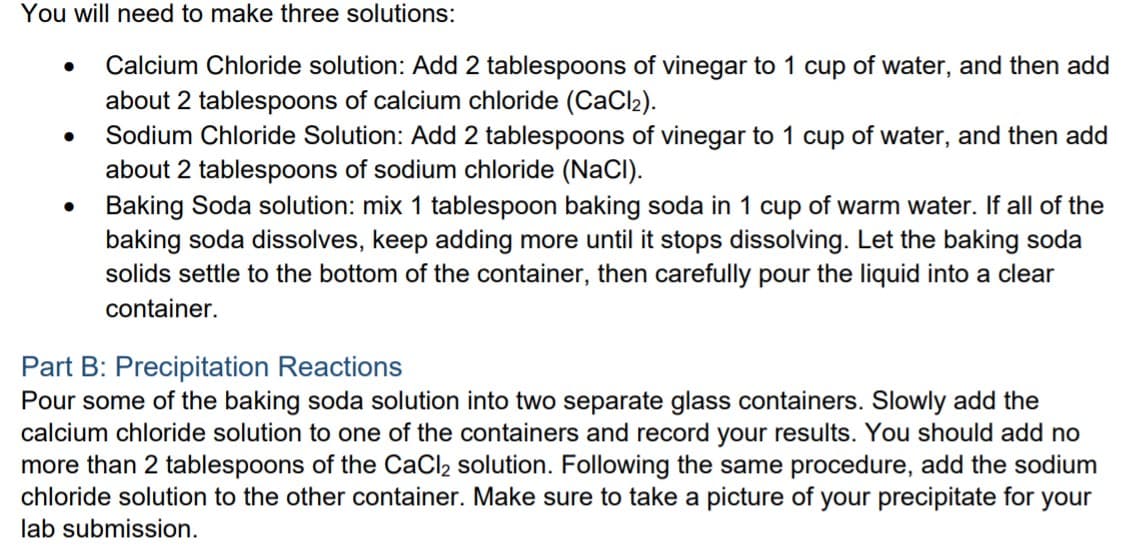1. Baking soda contains sodium bicarbonate (NaHCO3) which creates carbonate in solution. Write the balanced precipitation reactions observed in part b. If no reaction occurs, explain why a precipitate didn't form.
1. Baking soda contains sodium bicarbonate (NaHCO3) which creates carbonate in solution. Write the balanced precipitation reactions observed in part b. If no reaction occurs, explain why a precipitate didn't form.
General, Organic, and Biological Chemistry
7th Edition
ISBN:9781285853918
Author:H. Stephen Stoker
Publisher:H. Stephen Stoker
Chapter8: Solutions
Section: Chapter Questions
Problem 8.8EP: Classify each of the following solutions as saturated, unsaturated, or supersaturated based on the...
Related questions
Question
Write the balanced precipitation reactions

Transcribed Image Text:1. Baking soda contains sodium bicarbonate (NaHCO3) which creates carbonate in
solution. Write the balanced precipitation reactions observed in part b. If no reaction
occurs, explain why a precipitate didn't form.

Transcribed Image Text:You will need to make three solutions:
Calcium Chloride solution: Add 2 tablespoons of vinegar to 1 cup of water, and then add
about 2 tablespoons of calcium chloride (CaCl2).
Sodium Chloride Solution: Add 2 tablespoons of vinegar to 1 cup of water, and then add
about 2 tablespoons of sodium chloride (NaCI).
Baking Soda solution: mix 1 tablespoon baking soda in 1 cup of warm water. If all of the
baking soda dissolves, keep adding more until it stops dissolving. Let the baking soda
solids settle to the bottom of the container, then carefully pour the liquid into a clear
container.
Part B: Precipitation Reactions
Pour some of the baking soda solution into two separate glass containers. Slowly add the
calcium chloride solution to one of the containers and record your results. You should add no
more than 2 tablespoons of the CaCl2 solution. Following the same procedure, add the sodium
chloride solution to the other container. Make sure to take a picture of your precipitate for your
lab submission.
Expert Solution
This question has been solved!
Explore an expertly crafted, step-by-step solution for a thorough understanding of key concepts.
Step by step
Solved in 2 steps with 1 images

Knowledge Booster
Learn more about
Need a deep-dive on the concept behind this application? Look no further. Learn more about this topic, chemistry and related others by exploring similar questions and additional content below.Recommended textbooks for you

General, Organic, and Biological Chemistry
Chemistry
ISBN:
9781285853918
Author:
H. Stephen Stoker
Publisher:
Cengage Learning

Chemistry: The Molecular Science
Chemistry
ISBN:
9781285199047
Author:
John W. Moore, Conrad L. Stanitski
Publisher:
Cengage Learning

Introductory Chemistry: An Active Learning Approa…
Chemistry
ISBN:
9781305079250
Author:
Mark S. Cracolice, Ed Peters
Publisher:
Cengage Learning

General, Organic, and Biological Chemistry
Chemistry
ISBN:
9781285853918
Author:
H. Stephen Stoker
Publisher:
Cengage Learning

Chemistry: The Molecular Science
Chemistry
ISBN:
9781285199047
Author:
John W. Moore, Conrad L. Stanitski
Publisher:
Cengage Learning

Introductory Chemistry: An Active Learning Approa…
Chemistry
ISBN:
9781305079250
Author:
Mark S. Cracolice, Ed Peters
Publisher:
Cengage Learning


Chemistry: Principles and Reactions
Chemistry
ISBN:
9781305079373
Author:
William L. Masterton, Cecile N. Hurley
Publisher:
Cengage Learning

Chemistry & Chemical Reactivity
Chemistry
ISBN:
9781133949640
Author:
John C. Kotz, Paul M. Treichel, John Townsend, David Treichel
Publisher:
Cengage Learning